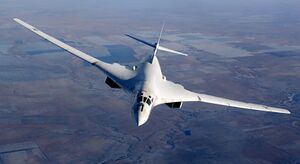AFSB-3 Fenice Strategic Bomber: Difference between revisions
mNo edit summary |
mNo edit summary |
||
| Line 11: | Line 11: | ||
|designer = | |designer = | ||
|builder = | |builder = | ||
|first flight = 9 September | |first flight = 9 September 1974 | ||
|introduction = | |introduction = | ||
|introduced = 22 June | |introduced = 22 June 1980 | ||
|retired = | |retired = | ||
|status = In active service | |status = In active service | ||
Revision as of 08:33, 7 May 2021
This article is incomplete because it is pending further input from participants, or it is a work-in-progress by one author. Please comment on this article's talk page to share your input, comments and questions. Note: To contribute to this article, you may need to seek help from the author(s) of this page. |
| Vulcan AFSB-3 Fenice | |
|---|---|

| |
| A Cacertian Royal Air Fleet AFSB-3 flying over Sarissita. | |
| Role | Strategic bomber |
| National origin | |
| Manufacturer | Vulcan Aeronautics |
| First flight | 9 September 1974 |
| Introduction | 22 June 1980 |
| Status | In active service |
| Primary user | |
| Produced | 1985—Present |
| Number built | 40+ |
| Unit cost |
ɫ290,000,000
|
| Variants | AFSB-3v1 AFSB-3v2 AFSB-3v3 |
The Vulcan AFSB-3 Fenice (Phoenix) is a supersonic, variable-sweep wing, heavy strategic bomber designed by the Vulcan Aeronautics Design Bureau for the Cacertian Royal Air Fleet. It is one of the largest, fastest, and heaviest supersonic military aircraft in the region and is capable of Mach 2+ flight. The Fenice entered service in 1987 after six years of development as part of the Royal Air Fleet’s Long Range Aviation Branch.
The Fenice was first envisioned following the success of the Spettro, combining Mach 2 speed with a heavier payload. A long series of studies culminated in the development of the Fenice which has a top speed of Mach 2.05 at high altitude and the ability of flying very long distances at Mach 0.9 at low altitudes. The very high cost of the Fenice, however, has limited its production in comparison to its predecessor.
During the FedCom Civil War, flights of Fenices were involved in the opening moves of the Cacertian Intervention by performing high-altitude strikes on Optikhalee positions. AFSB-3s are known to be forward-deployed at bases in Solaris and Andria.
Development
Design
Operational History
Variants
- AFSB-3
The production version of the AFSB-3 that entered service in 1987.
- AFSB-3v1
The 3v1 is the modern and upgraded version of the Fenice which features new weaponry, improved electronics and avionics.
- AFSB-3v2
Making its first flight in 2005, the AFSB-3v2 is an electronic warfare version of the Fenice that carries stand-off jamming and ECM equipment.
- AFSB-3v3
Unveiled in 2015, the AFSB-3v3 features low observable technology and more powerful and efficient engines. As a result, it possesses greater operational range, electronics, a glass cockpit, advanced communications and control systems, and a new array of weaponry.
Operators
 Cacerta; Cacertian Royal Air Fleet—36 AFSB-3s of differing variations in service with the Royal Air Fleet.
Cacerta; Cacertian Royal Air Fleet—36 AFSB-3s of differing variations in service with the Royal Air Fleet. Quenmin; Imperial and Royal Quenminese Aerial Force—8 models purchased, majority v2.
Quenmin; Imperial and Royal Quenminese Aerial Force—8 models purchased, majority v2. Ruvelka; Ruvelkan Imperial Air Force—6 AFSB-3v1s and 2 AFSB-3v2s purchased as part of the Ruvelkan military’s rearmament after the Zemplen War.
Ruvelka; Ruvelkan Imperial Air Force—6 AFSB-3v1s and 2 AFSB-3v2s purchased as part of the Ruvelkan military’s rearmament after the Zemplen War.
Specifications (AFSB-3)
General Characteristics
- Crew: 4 (pilot, co-pilot, weapon systems officer, defensive systems officer)
- Length: 54.1 m (177 ft 6 in)
- Wingspan: 55.7 m (182 ft 9 in) spread (20° sweep); 35.6 m (117 ft) swept (65° sweep)
- Height: 13.1 m (43 ft)
- Wing Area: 400 m² (4,300 ft²) spread (20° sweep); 360 m² (3,875 ft²) swept (65° sweep)
- Empty Weight: 110,000 kg (242,508 lbs)
- Gross Weight: 267,600 kg (589,957 lbs)
- Max Takeoff Weight: 275,000 kg (606,271 lbs)
- Powerplant: 4 × EDA-Fenice Afterburning Turbofans
Performance
- Maximum Speed: Mach 2.05 (2,220 km/h, 1,380 mph) at altitude
- Cruising Speed: Mach 0.9 (960 km/h, 600 mph)
- Range: 12,300 km (7,600 mi, 6,600 nmi)
- Combat Range: 2,000 km (1,200 mi, 1,100 nmi) maintaining Mach 1.5
- Service Ceiling: 16,000 m (51,000 ft)
- Rate of Climb: 70 m/s (14,000 ft/min)
- Wing Loading: 742 kg/m² (152 lb/ft²)
- Thrust/Weight: 0.37
Armament
- Payload: 45,000 kg (99,208 lb) within internal weapons bays
